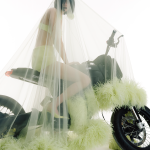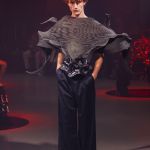
Has Paris Fashion Week become more prudish?
Fashion, this season, was quite bourgeois
October 4th, 2024
The concept of “creative risk” was the most frequently used among critics who commented on Paris Fashion Week, which concluded last Tuesday with Coperni's fireworks, perhaps brighter than the collection they accompanied. Increasingly, the subject of each collection seems subordinate to its presentation in a kind of trend towards meta-narrativity, where many creative directors and brands appear more focused on the continuity and context of the narrative rather than the narrative itself, getting stuck in a self-referentiality and, in some cases, self-indulgence that has led them to "perform" themselves rather than to be themselves, adhering to an external image of their style rather than sincerely developing it. To observe oneself from the outside means having stopped growing: as D'Annunzio once said, «anatomy presupposes the corpse». This was the case with the aforementioned Coperni, whose designers seemed more interested in creating a "moment" than innovating the clothes, but it was also the case with Rick Owens, who, despite remaining a venerable master, has started to seem mechanical with his unjustified fixation on the Palais de Tokyo, the glacial pace of his show, and the slow redundancy of an ever-identical collection. Almost as if he is starting to lose flexibility and adaptability, becoming verbose, repetitive, and less energetic. Why not change location at least once? He and others would benefit from a sense of healthy synthesis, swiftness, and salience.
In fact, conciseness was the hallmark of the season’s winning shows, both qualitatively and quantitatively. We’re not generally speaking of minimalism; on the contrary, reductionism has even disappeared in favor of ample volumes, a proliferation of lace, lingerie, and transparency; of extremely short hemlines or imposing tailored garments; of layered outfits, capes, and feathers. We are referring to the ability to say what one has to say, even if little, in a succinct, efficient manner, without obfuscation. Look at The Row and its twenty-seven looks, which may not revolutionize the world of design but make for an agile, direct, and effective presentation; look at Peter Do and his densely packed brevity, at Mugler, Noir Kei Ninomiya, Anrealage, Enfants Riches Dèprimés, and Heliot Emil. All brands that limited themselves to around thirty looks, unlike other brands that exceeded fifty looks, often diluting their message—if there was a message to begin with. Many other designers, including the most renowned, opted for tedious self-indulgence, which suggests effort but also a refusal to challenge themselves, a failure to realize they’ve become boring. The result was collections that were somewhat generic, forgettable, more inclined to follow trends than to create them, genuflecting to the algorithm or simply indicating that the creative directors or designers involved have stopped questioning their own work: any creative who does not become their own most severe, relentless, and ruthless critic is doomed to become a parody of themselves.
@nssmagazine We met Henri Alexander after the latest Enfants Riches Déprimés show: we talked about music, obsessions and what next for the depressed rich kids. #tiktokfashion #fashiontiktok #parisfashionweek #pfw #erd #enfantsrichesdéprimés #enfantsrichesdeprimes #paris original sound - nss magazine
Aside from notable exceptions like Courrèges, Issey Miyake, or Yohji Yamamoto, where there was a discernible passion or at least the feverish excitement of creation, the overall feeling after this fashion month is that institutional fashion has become too “safe” to express anything truly real. The presence of “responsible adults” in the form of CEOs, investors, and committees instead of the patrons of the past has created fashion carried out with the same inert diligence and obtuse candor as a school assignment, even coy in its rebellion, as exciting as an accounting review—in a word, bourgeois. Where has the irreverence of the past gone? Where is the unexpected, the thrill? It's like a school dance where all the parents and teachers are present as chaperones: there will certainly be no incidents, but the party will be dreadfully boring. Even the generous amounts of bare legs, high heels, miniskirts, and bare breasts visible through sheer dresses had nothing sensual about them; they seemed more like the product of a frigid imagination, the idea of sex from someone who has never experienced it.And the same did not translate to the audience, whose members, at least those free to adopt the styling they preferred, often proved to be more advanced in terms of styling and taste than the looks on the runway. This leads us to wonder who the real tastemakers of fashion are—whether the designers or their followers—and, more importantly, whether designers, amidst their many corporate and commercial constraints, are still capable of synthesizing and evoking, as they once did, the emotion that is the cornerstone of fashion: desire.
Is this a bridal look from Luis de Javier? pic.twitter.com/D6DCOkpnnZ
— justice Kelly (@softlyemerging) September 25, 2024
It’s not a matter of nudity—if that were enough, Luis de Javier's show, with its crude, fetishistic sex-doll brides, would have made sense, but it didn’t. Take McQueen, for example: Sean McGirr doesn’t seem to have a clear idea of what makes a woman sexy—whether due to restraint or disinterest, the grim banshees he conjured were as rigid as nuns. The kind of sensuality that, in his time, Lee McQueen established more through the anatomical cut of the garments, the dizzying plunge of the necklines, the way a dress seemed on the verge of revealing something without ever really doing so—it’s no coincidence that even his less successful shows (and here we think of the SS06 collection that played with a similar type of tailoring) evoked a shiver of eroticism, perhaps aggressive but never degrading, au contraire, liberating, celebratory. It’s as if many designers have become stuck between two modes of sexiness: completely inoffensive or completely offensive, prudish or pornographic. The most subtly provocative detail seen this week was that strip of bare skin under the navel of Balenciaga’s models, between a short polo and low-rise jeans. The imagination of Parisian designers didn’t go much further than that.
In any case, the feeling is that we are once again in the early '90s, with the same crisis that was felt back then, caused by the progressive decline of historic brands fossilized in an outdated business and communication model. A fatigue undoubtedly due to the fact that all corners of the map have been explored, that everything has already been seen and invented, creating the impression of having reached the end of history—but the problem is also an apprehensive, overly cautious corporate culture. Even designers, frankly, seem short on ideas, but that’s because too many are working on the same things—it’s only natural that they overlap and interchange with each other. But when the sand is at the bottom of the hourglass, all it takes is to turn the hourglass: incidentally, these are precisely the moments when a rupture, a trauma, or a fracture occurs that shakes up a sclerotic system, too big to collapse in a day but already partially decomposing. Who remembers how Marc Jacobs got fired from the elegant Perry Ellis for his famous grunge collection? Today, the only reason people remember Perry Ellis exists is exactly that moment of disobedience—the executives in their shirts would do well to remember it.



















































